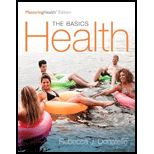
Health: The Basics, The Mastering Health Edition (12th Edition)
12th Edition
ISBN: 9780134183268
Author: Rebecca J. Donatelle
Publisher: PEARSON
expand_more
expand_more
format_list_bulleted
Question
Chapter 12, Problem 2TAI
Summary Introduction
To determine: The overall health of an individual on the resting heart rate.
Introduction:
Cardiovascular system refers to the network of vessels and organs in which the flow of blood takes place. The blood flow helps in carrying the oxygen and nutrients to all the parts of the human body.
Expert Solution & Answer
Want to see the full answer?
Check out a sample textbook solution
Chapter 12 Solutions
Health: The Basics, The Mastering Health Edition (12th Edition)
Ch. 12 - How do we determine whether a behavior or...Ch. 12 - Do you think that there should be legislation...Ch. 12 - Prob. 1PQCh. 12 - Prob. 2PQCh. 12 - Prob. 3PQCh. 12 - Prob. 4PQCh. 12 - Prob. 5PQCh. 12 - Prob. 6PQCh. 12 - When cancer cells have metastasized, a. they have...Ch. 12 - One of the biggest factors in increased risk for...
Ch. 12 - Prob. 9PQCh. 12 - Prob. 10PQCh. 12 - Prob. 1TAICh. 12 - Prob. 2TAICh. 12 - Prob. 3TAICh. 12 - Prob. 4TAICh. 12 - Prob. 5TAICh. 12 - What accounts for the improvement in 5-year...Ch. 12 - Prob. 7TAICh. 12 - Prob. 8TAICh. 12 - What are the differences between carcinomas,...Ch. 12 - Do any of your primary relatives (parents,...Ch. 12 - Prob. 2AYCh. 12 - Prob. 3AYCh. 12 - Prob. 4AYCh. 12 - Prob. 5AYCh. 12 - Prob. 6AYCh. 12 - Prob. 7AYCh. 12 - Prob. 8AYCh. 12 - Prob. 9AYCh. 12 - Prob. 10AYCh. 12 - Prob. 11AYCh. 12 - Prob. 12AYCh. 12 - Prob. 13AYCh. 12 - Prob. 14AYCh. 12 - Prob. 15AYCh. 12 - Prob. 16AYCh. 12 - Prob. 1PQACh. 12 - Prob. 2PQACh. 12 - Prob. 3PQA
Knowledge Booster
Similar questions
- For whom would an appreciation of the structural characteristics of the human heart come more easily: an alien who lands on Earth, abducts a human, and dissects his heart, or an anatomy and physiology student performing a dissection of the heart on her very first day of class? Why?arrow_forward_____ contraction drives blood through the systemic and pulmonary circuits; outside the heart, blood pressure is highest in the _____. a. Atrial; ventricles b. Atrial; atria c. Ventricular; arteries d. Ventricular; aortaarrow_forwardWhich of the following lists the valves in the order through which the blood flows from the vena cava through the heart? tricuspid, pulmonary semilunar, bicuspid, aortic semilunar mitral, pulmonary semilunar, bicuspid, aortic semilunar aortic semilunar, pulmonary semilunar, tricuspid, bicuspid bicuspid, aortic semilunar, tricuspid, pulmonary semilunararrow_forward
Recommended textbooks for you
 Human Physiology: From Cells to Systems (MindTap ...BiologyISBN:9781285866932Author:Lauralee SherwoodPublisher:Cengage LearningCase Studies In Health Information ManagementBiologyISBN:9781337676908Author:SCHNERINGPublisher:Cengage
Human Physiology: From Cells to Systems (MindTap ...BiologyISBN:9781285866932Author:Lauralee SherwoodPublisher:Cengage LearningCase Studies In Health Information ManagementBiologyISBN:9781337676908Author:SCHNERINGPublisher:Cengage


Human Physiology: From Cells to Systems (MindTap ...
Biology
ISBN:9781285866932
Author:Lauralee Sherwood
Publisher:Cengage Learning

Case Studies In Health Information Management
Biology
ISBN:9781337676908
Author:SCHNERING
Publisher:Cengage


